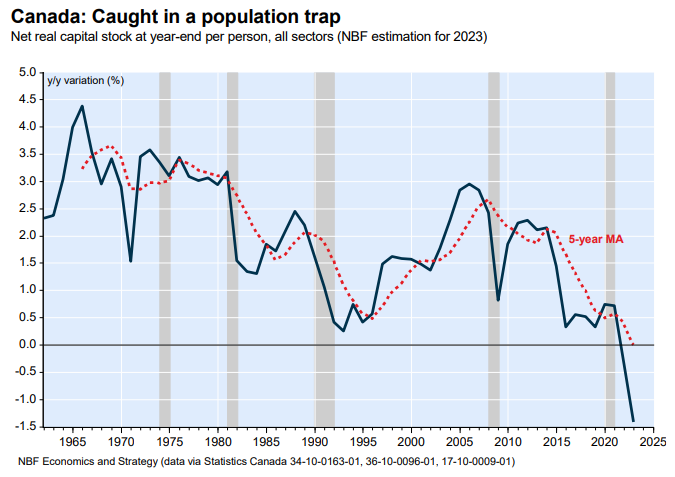On Saturday morning, I was interviewed by Luke Grant on Radio 2GB where we dissected former NSW Premier Dominic Perrottet’s claim that Australia’s mass immigration policy is “lazy economics” and a “ponzi scheme”.
I also explained why Australia is caught in a “population trap of falling productivity” because the nation’s population is growing much faster than business investment, infrastructure, and housing.
We also talked about the most recent cost of living survey from the Australian Bureau of Statistics (ABS), which reveals that while self-funded retirees are doing well, employee households are suffering from rising rents, mortgage payments, and income taxes.
Below are highlights from the interview, along with key charts.
On Dominic Perrottet’s call to cut immigration:
Australian politicians have this knack that as soon as they leave office, they start telling the truth.
Politicians become honest once they are no longer in charge. We saw it again with former Premier Dominic Perrottet.
Remember in 2021 when he took over the premiership from Gladys? Perrottet actually said that Australia needed this “time-limited” doubling of pre-covid immigration levels. He said we needed a ‘Big NSW’. He was unashamedly in favor of basically doubling the immigration intake for a period of five years.
Now obviously the Albanese government’s has done that for a year, not for 5 years. And now Dominic Perrottet is no longer the leader.
Perrottet told the Property Council that Australia is running a “lazy” immigration system that it is a “ponzi scheme”.
Perrottet complained that the states are overburdened. The feds get most of the benefit because they collect most of the tax revenue from company taxes and personal income taxes. And the states are basically getting ripped off and we need to moderate migration.
He also complained that he’s seven kids or something like that and they’re going to struggle to afford housing and that nothing is keeping up.
We’re not building enough homes, we’re not building enough infrastructure, and all this sort of thing. And it’s a lazy way to grow.
What Perrottet said was 100% correct. We all know it. The problem is, Perrottet talked a very different book to what he did two and a half years ago. Now he’s had this this Damascus moment where he’s finally telling the truth.
It is a Ponzi scheme, it is unsustainable, and we need to dial migration right back.
If you live in Sydney, you live with traffic congestion every day. You’re seeing high-rise dog boxes going up all around you. Your quality of life is getting worse.
The housing affordability situation is absolutely shocking. The rental market is an absolute disaster. The median house price in Sydney is now $1.6 million.
It has become a nightmare, and that’s the reason why so many Sydneysiders are moving north to Queensland because they can’t afford to live there anymore.
The federal government is basically fire-hosing net overseas migrants into Sydney. That’s like pushing on one side of a balloon. It’s pushing the existing residents out of Sydney.
And according to the official forecasts, Sydney’s population is meant to hit about 9 million people by the 2060s. It’s an unsustainable situation.
On Australia’s collapsing productivity:
The governor Reserve Bank fronted up to a parliamentary inquiry on Friday and said that Australia’s has got to get its productivity performance up if we want to have real wage growth, which is basically correct.
There’s a very good economist named Justin Fabo who runs the site Antipodean Macro. He did an analysis plotting Australia’s productivity growth – GDP per hour worked – against a whole bunch of advanced nations:

Australia was the worst. We’ve effectively had no productivity growth since 2016, whereas the other nations have at least grown productivity.
A key reason is that Australia is running this big immigration system. So effectively, what’s happened is we’ve experienced a long period of what’s called “capital shallowing”.
That’s effectively when your population grows faster than your business investment, your infrastructure, and housing. You get less capital per person.

That basically destroys your productivity – for example through higher congestion costs. If you bring in all those people and you don’t build enough infrastructure for them, then it takes you longer to get from A to B. That wrecks productivity.
That is effectively what Australia’s economic growth model has been since the mid-2000s when we massively ramped-up immigration and we haven’t built anything to keep up.
The interesting thing is the other country which also has experienced incredibly poor productivity growth is Canada, which has done exactly the same thing.
Canada’s got all the same problems as us. They’ve run a massive immigration program. They did 1.2 million last year, so they even worse than us.

Some excellent economists at the National Bank of Canada did a massive study last month and they said that Canada is caught in a “population trap” because they’re getting this capital shallowing problem:

Gerard Minack, who is a great Australian economist, did a similar study on Australia in November and found the same thing. One of the main reasons for Australia’s poor productivity performance is because we’ve been growing the population much faster than we’ve grown infrastructure, business investment, etc.

Source: Gerard Minack
Unfortunately, you’ll never see the Reserve Bank Governor say that we need to slow immigration down so that the population grows at a slower rate than business investment, infrastructure or housing. They never say that. They always point to these other things, and they talk in motherhood statements.
They never call out the immigration elephant in the room.

